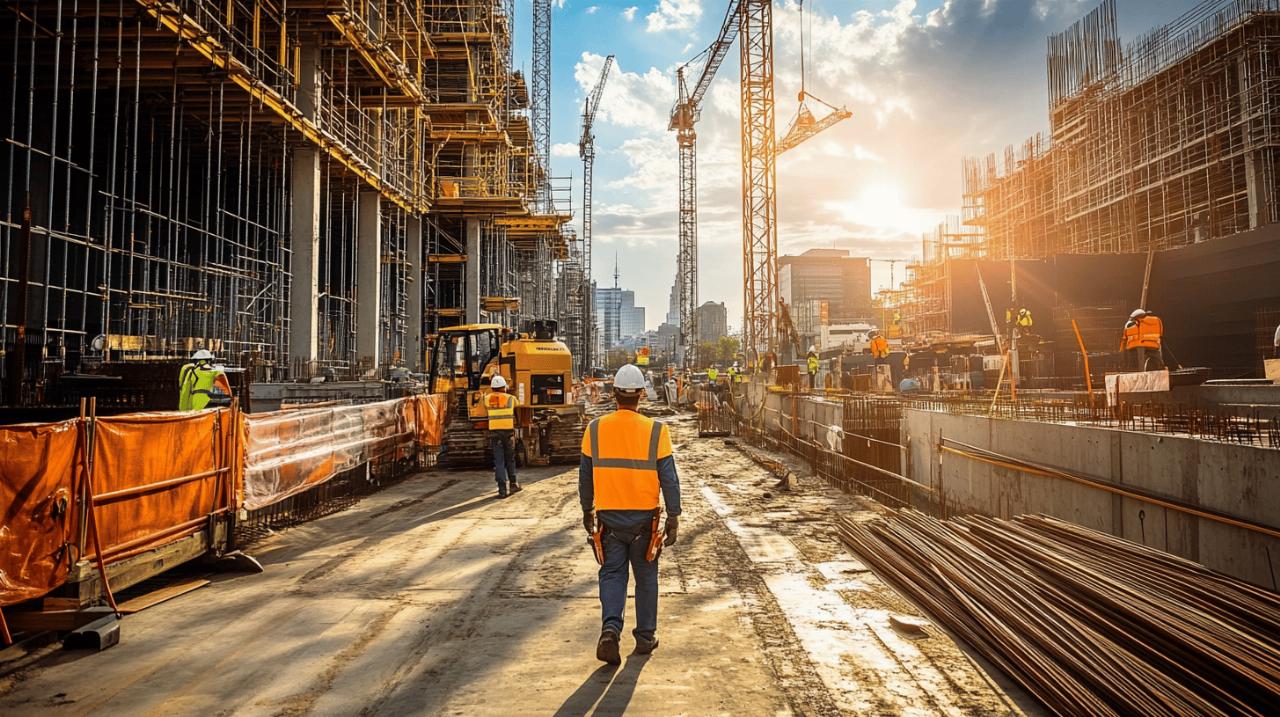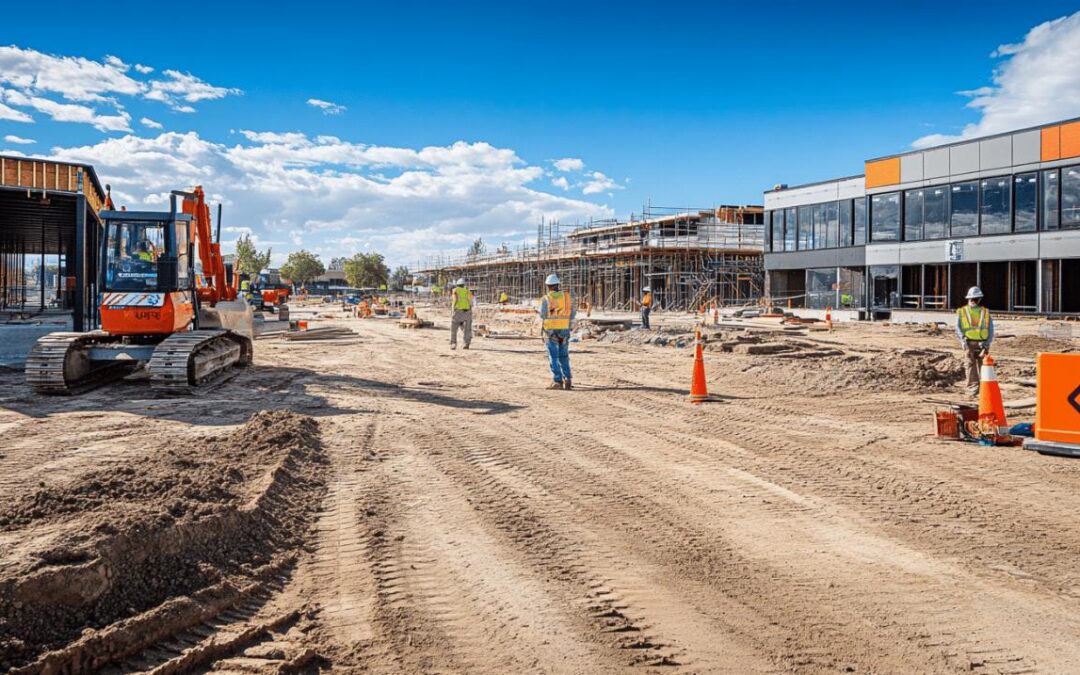Construction site panels serve as powerful marketing tools that not only enhance site safety but can significantly boost your company’s public image and brand recognition. When designed thoughtfully, these panels transform ordinary construction boundaries into effective advertising spaces that communicate professionalism and expertise. This comprehensive guide explores the essential elements of creating impactful construction site panels that will elevate your company’s presence in the industry.
Creating a professional visual identity
The visual identity displayed on your construction site panels forms the first impression potential clients will have of your business. Criterio Selecta‘s industry analysis indicates that companies with cohesive, professional panel designs experience enhanced brand recognition and client trust. Your panels should immediately communicate quality and reliability through their visual elements, establishing your firm as a serious industry contender before prospects even make contact.
Balancing clean design with brand recognition
Effective site hoarding advertisements strike a delicate balance between simplicity and distinctive branding. Overcrowded designs with excessive information can appear chaotic and unprofessional, while overly minimalist approaches might fail to make an impression. The key is creating clean, uncluttered layouts that allow your core message and branding to stand out. This approach ensures your panels communicate effectively even to viewers passing by at a distance or in vehicles.
Selecting the Right Colour Scheme for Maximum Impact
Colour selection dramatically affects the visibility and impact of your construction graphics. High-contrast colour combinations increase readability from a distance, while strategic use of your brand colours reinforces recognition. Consider how your chosen palette will appear in different lighting conditions throughout the day and how it will complement or stand out against the surrounding environment. Bold, vibrant colours can draw attention in busy urban settings, while more subdued tones might be appropriate for sensitive or historical locations.
Crafting clear and effective messaging
The message on your construction hoarding should be concise, compelling, and instantly comprehensible. Unlike detailed marketing materials, site panels must communicate their core message in seconds to passing traffic and pedestrians. Focus on distilling your value proposition into a clear statement that resonates with your target audience and positions your company as the obvious choice for their construction needs.
Optimising Text Size and Readability from Distance
Text legibility is crucial for effective construction site marketing. Typography should be bold and clear, with sufficient size to be readable from various distances. Sans-serif fonts typically offer better visibility on large format displays. Consider the viewing distance when determining text size – a good rule is that text should be visible from at least 30-50 metres away for vehicular traffic areas. This approach ensures your messaging reaches the widest possible audience, maximising the advertising effectiveness of your panels.
Structuring information hierarchy for quick comprehension
Organise information on your panels according to importance, with primary messages receiving the most prominence through size, position, and contrast. Secondary information should support the main message without competing for attention. This hierarchy guides viewers through your content naturally, ensuring they absorb key points even during brief exposure. Remember that most viewers will only glance at your panels for a few seconds, making strategic information structuring essential for effective communication.
Branding elements and logo placement
Your company’s visual identifiers are central to effective construction branding. The strategic placement and presentation of these elements can significantly enhance brand awareness and recognition among your target audience. Construction sites offer unique, large-scale advertising spaces that, when leveraged correctly, create powerful brand impressions in the community.
Strategic positioning of company identifiers
Logo placement should be prominent yet harmonious with the overall design. The most effective positioning typically places logos in the upper portion of panels where they remain visible even when vehicles or pedestrians partially block lower sections. Consider incorporating your logo multiple times if you have extensive hoarding, ensuring brand visibility from various angles and approaches. The size of your logo should be proportionate to the panel dimensions while remaining boldly visible from appropriate viewing distances.
Maintaining brand consistency across multiple sites
For companies managing multiple construction projects simultaneously, maintaining visual consistency across all site hoardings strengthens brand recognition. Develop a standardised template that allows for project-specific information while preserving core brand elements. This consistency creates cumulative marketing impact as people encounter your distinctive brand identity across different locations. Ensure all promotional barriers follow the same design principles, colour schemes, and branding guidelines to build a cohesive company image throughout your operational territory.
Material selection and production quality
The physical quality of your construction site panels significantly influences how your company is perceived. Premium materials and professional production communicate attention to detail and high standards – qualities prospects will associate with your construction work itself. Investing in superior materials often proves cost-effective by extending the lifespan of your panels and maintaining their professional appearance throughout the project duration.
Weather-resistant options for long-term display
Construction projects typically span months or years, exposing site panels to challenging weather conditions. Select materials specifically designed for outdoor durability, including UV-resistant inks that prevent fading and waterproof substrates that resist warping, peeling, and deterioration. Modern eco-friendly hoarding options combine environmental responsibility with excellent durability, allowing your panels to maintain their impact throughout the project while aligning with sustainability commitments.
Print quality considerations for professional appearance
The print resolution and finish quality of your panels directly reflect your company’s professionalism. Pixelated images, blurry text, or poor colour reproduction can undermine even the best design concepts. Work with specialist hoarding printing services experienced in large-format production to ensure sharp, vibrant results. Consider how different finishes (matte, satin, or gloss) might enhance your design while factoring in potential glare issues in your specific location.
Contextual design considerations
 The physical and cultural context surrounding your construction site should inform your panel design choices. A panel that looks striking in one environment might appear jarring or inappropriate in another. Taking time to consider the specific context of each site demonstrates thoughtfulness and community respect, enhancing your company’s image among local stakeholders.
The physical and cultural context surrounding your construction site should inform your panel design choices. A panel that looks striking in one environment might appear jarring or inappropriate in another. Taking time to consider the specific context of each site demonstrates thoughtfulness and community respect, enhancing your company’s image among local stakeholders.
Adapting Panel Design to Urban vs Rural Environments
Urban environments typically feature more visual competition, requiring bolder designs to stand out among surrounding advertisements and architecture. Conversely, rural or suburban settings may benefit from more harmonious approaches that complement rather than dominate the landscape. Consider the speed at which people typically pass your site – busy city centres with pedestrian traffic allow for more detailed designs, while highway-adjacent sites require simpler, more immediate visual impact.
Creating visual harmony with surrounding architecture
Thoughtful construction graphics can complement or reference nearby architectural styles, creating a sense of visual belonging rather than disruption. This approach demonstrates environmental awareness and respect for the existing community character. For historic areas or sensitive locations, designs that acknowledge architectural heritage can transform potential community resistance into appreciation for your thoughtful approach to the project.
Essential contact information integration
While aesthetic considerations are important, construction site panels must ultimately drive business outcomes through effective lead generation. Strategic integration of contact information transforms passive viewers into potential clients. However, contact details must be incorporated without compromising the overall design integrity or creating visual clutter.
Balancing accessibility with visual clutter
Include essential contact methods like phone numbers, websites, and email addresses in a clear, accessible format without overwhelming the design. Position contact information where it’s easily noticed but not at the expense of your primary message or visual impact. Consider using simplified website URLs or memorable phone numbers that viewers can recall after passing your site. The goal is making it easy for interested prospects to reach you without cluttering your design with excessive text.
Digital integration options for enhanced engagement
Modern interactive features like QR codes provide powerful ways to extend engagement beyond the physical hoarding. These digital touchpoints can direct interested viewers to project websites, virtual tours, or registration forms for updates. When implemented thoughtfully, these elements enhance community engagement while generating valuable leads. Consider incorporating social media handles to encourage online following and create additional touchpoints with your brand.
Showcasing expertise and portfolio
Your construction site panels offer an opportunity to demonstrate your company’s capabilities and track record directly to the local market. Effectively highlighting relevant expertise builds confidence in your ability to deliver similar results for potential clients. This approach transforms standard site barriers into powerful testimonials to your company’s skills and experience.
Featuring relevant project highlights and achievements
Include images or renderings of completed projects that showcase your company’s best work, particularly those similar to the current construction. Visual examples of successful outcomes help viewers envision the potential transformation of the current site. When appropriate, incorporate testimonials or recognition from previous clients or industry awards to build credibility. These elements validate your expertise and establish trust with prospective clients.
Demonstrating specialised skills and services
Highlight particular capabilities that differentiate your company from competitors. Whether it’s sustainable building practices, innovative construction techniques, or specialised sector expertise, your panels should communicate your unique value proposition. This focus helps attract clients seeking your specific strengths while positioning your company as an industry leader in your chosen specialisations.
Regulatory compliance and safety standards
Professional construction companies demonstrate their commitment to legal and safety compliance through every aspect of their operations, including site panels. Ensuring your hoardings meet all relevant regulations protects your company from potential fines while reinforcing your professional image. This attention to compliance details signals to clients that you maintain similar standards throughout your construction practices.
Understanding local planning requirements for signage
Regulations regarding construction site advertising vary significantly between jurisdictions, with particular restrictions often applying in conservation areas, historic districts, or scenic locations. Research local planning requirements before designing your panels to ensure compliance with size limitations, content restrictions, and permit requirements. This proactive approach prevents potential delays or enforcement issues that could damage your company’s reputation and project timeline.
Health and safety information requirements
Many jurisdictions require specific safety information to be displayed prominently on construction site boundaries. These typically include emergency contact details, site manager information, and relevant warning notices. Integrate these mandatory elements into your design in a way that maintains aesthetic quality while ensuring compliance. Well-designed safety information demonstrates your commitment to public protection and responsible construction practices, further enhancing your professional image in the community.

